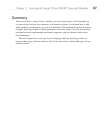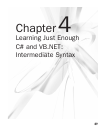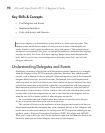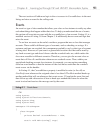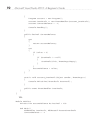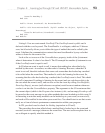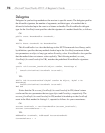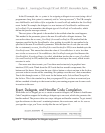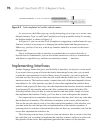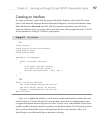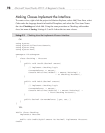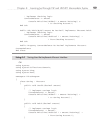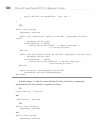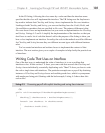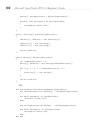
Chapter 4: Learning Just Enough C# and VB.NET: Intermediate Syntax 95
In the C# example, the += syntax is for assigning a delegate to an event (using a bit of
programmer slang, this syntax is commonly said to “wire up an event”). The
VB example
uses AddHandler and AddressOf to assign the AccountOverDraft method to the OverDraft
event. In the C# example, the delegate is a new instance of EventHandler and the event
is OverDraft. If you remember, the delegate type of OverDraft is Eventhandler, which
defines the precise message contract.
The next piece of the puzzle is the method to be notified when the event happens.
This method is the parameter given to the new EventHandler delegate instance. You
saw earlier where the account_OverDraft (AccountOverDraft in VB) method had the
signature specified by the EventHandler class, making it possible for our method to be
specified as the new EventHandler parameter. With that one line of code (the one with
the += statement), account_OverDraft (AccountOverdraft in VB) is now hooked up to the
OverDraft event. This means that when the value of CurrentBalance is set to less than
zero via the set accessor of CurrentBalance, the OverDraft event gets fired because the
OverDraft(this, EventArgs.Empty) is called, which then invokes the account_OverDraft
(AccountOverdraft in VB) method (the method we wired up to the event), which in turn
executes its code.
One more note about events: you’ll see them used extensively in graphical user
interface (GUI) code. Think about the GUI code that has reusable components, like
buttons and list boxes. Every time the user clicks a button or selects an item in the list box,
you want code to execute and do something, like perhaps save the user’
s data somewhere.
You do this through events: a Click event for the button and a SelectedItemChanged for
the list box. This is the standard way that you program GUIs; you have an event and you
define a method to hook up to that event so that your running program can do some work
in reaction to the user.
Event, Delegate, and Handler Code Completion
While there isn’t a snippet, per se, to create an event or delegate, in C# there is Intellisense
Code Completion support for hooking a delegate up to an event, which also generates the
handler method. The process takes two steps: delegate and handler creation. To get started,
type the reference to the event’s containing instance, the event name, and +=. As soon as
you type the = sign, you’ll see a tooltip like the one in Figure 4-1.
Figure 4-1 Code completion for delegate assignment



